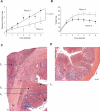Bacteria and bacterial rRNA genes associated with the development of colitis in IL-10(-/-) mice
- PMID: 18381614
- PMCID: PMC3804113
- DOI: 10.1002/ibd.20442
Bacteria and bacterial rRNA genes associated with the development of colitis in IL-10(-/-) mice
Abstract
Background: Microorganisms appear to play important yet ill-defined roles in the etiology of inflammatory bowel disease (IBD). This study utilized a novel population-based approach to identify bacteria and bacterial rRNA genes associated with the development of colitis in IL-10(-/-) mice.
Methods: Mice were housed in 2 environments: a community mouse facility where the mice were fed nonsterile chow (Room 3) and a limited access facility where the mice were fed sterile chow (Room 4). Every month the disease activity levels were assessed and fecal bacterial compositions were analyzed. At the end of the experiments histological and bacterial analyses were performed on intestinal tissue.
Results: Although disease activity increased over time in both environments, it progressed at a faster rate in Room 3 than Room 4. Culture and culture-independent bacterial analyses identified several isolates and phylotypes associated with colitis. Two phylotypes (GpC2 and Gp66) were distinguished by their negative associations with disease activity in fecal and tissue samples. Notably, rRNA genes from these phylotypes had high sequence identity (99%) to an rRNA gene from a previously described flagellated Clostridium (Lachnospiraceae bacterium A4).
Conclusions: The negative associations of these 2 phylotypes (GpC2 and Gp66) suggest that these bacteria were being immunologically targeted, consistent with prior findings that the Lachnospiraceae bacterium A4 bears a prevalent flagellar antigen for disease-associated immunity in murine immune colitis and human Crohn's disease. Identification of these associations suggests that the experimental approach used in this study will have considerable utility in elucidating the host-microbe interactions underlying IBD.
Figures


Similar articles
-
A novel urease-negative Helicobacter species associated with colitis and typhlitis in IL-10-deficient mice.Infect Immun. 1999 Apr;67(4):1757-62. doi: 10.1128/IAI.67.4.1757-1762.1999. Infect Immun. 1999. PMID: 10085015 Free PMC article.
-
Tolerance towards resident intestinal flora in mice is abrogated in experimental colitis and restored by treatment with interleukin-10 or antibodies to interleukin-12.Eur J Immunol. 1996 Apr;26(4):934-8. doi: 10.1002/eji.1830260432. Eur J Immunol. 1996. PMID: 8625991
-
Enteric Delivery of Regenerating Family Member 3 alpha Alters the Intestinal Microbiota and Controls Inflammation in Mice With Colitis.Gastroenterology. 2018 Mar;154(4):1009-1023.e14. doi: 10.1053/j.gastro.2017.11.003. Epub 2017 Nov 11. Gastroenterology. 2018. PMID: 29133078
-
High-resolution gene expression profiling using RNA sequencing in patients with inflammatory bowel disease and in mouse models of colitis.J Crohns Colitis. 2015 Jun;9(6):492-506. doi: 10.1093/ecco-jcc/jjv050. Epub 2015 Mar 20. J Crohns Colitis. 2015. PMID: 25795566
-
The C3H/HeJBir mouse model: a high susceptibility phenotype for colitis.Int Rev Immunol. 2000;19(1):63-75. doi: 10.3109/08830180009048390. Int Rev Immunol. 2000. PMID: 10723678 Review.
Cited by
-
A Novel Prebiotic Blend Product Prevents Irritable Bowel Syndrome in Mice by Improving Gut Microbiota and Modulating Immune Response.Nutrients. 2017 Dec 9;9(12):1341. doi: 10.3390/nu9121341. Nutrients. 2017. PMID: 29232851 Free PMC article.
-
The effect of peanut skins as a natural antimicrobial feed additive on ileal and cecal microbiota in broiler chickens inoculated with Salmonella enterica Enteritidis.Poult Sci. 2024 Nov;103(11):104159. doi: 10.1016/j.psj.2024.104159. Epub 2024 Aug 5. Poult Sci. 2024. PMID: 39153270 Free PMC article.
-
Regulatory effect of Garidisan on dysbiosis of the gut microbiota in the mouse model of ulcerative colitis induced by dextran sulfate sodium.BMC Complement Altern Med. 2019 Nov 21;19(1):329. doi: 10.1186/s12906-019-2750-y. BMC Complement Altern Med. 2019. PMID: 31752807 Free PMC article.
-
Effect of exclusive enteral nutrition on the microbiota of children with newly diagnosed Crohn's disease.Clin Transl Gastroenterol. 2015 Jan 15;6(1):e71. doi: 10.1038/ctg.2014.21. Clin Transl Gastroenterol. 2015. PMID: 25588524 Free PMC article.
-
Association of the Gut Microbiota With Cognitive Function in Midlife.JAMA Netw Open. 2022 Feb 1;5(2):e2143941. doi: 10.1001/jamanetworkopen.2021.43941. JAMA Netw Open. 2022. PMID: 35133436 Free PMC article.
References
-
- Eckburg PB, Relman DA. The role of microbes in Crohn's disease. Clin Infect Dis. 2007;44:256–262. - PubMed
-
- Sartor RB. Mechanisms of disease: pathogenesis of Crohn's disease and ulcerative colitis. Nat Clin Pract Gastr. 2006;3:390–407. - PubMed
-
- Xavier RJ, Podolsky DK. Unravelling the pathogenesis of inflammatory bowel disease. Nature. 2007;448:427–434. - PubMed
-
- Rath HC. The role of endogenous bacterial flora: bystander or the necessary prerequisite? Eur J Gastroenterol Hepatol. 2003;15:615–620. - PubMed
-
- D'Haens GR, Geboes K, Peeters M, et al. Early lesions of recurrent Crohn's disease caused by infusion of intestinal contents in excluded ileum. Gastroenterology. 1998;114:262–267. - PubMed
Publication types
MeSH terms
Substances
Grants and funding
LinkOut - more resources
Full Text Sources
